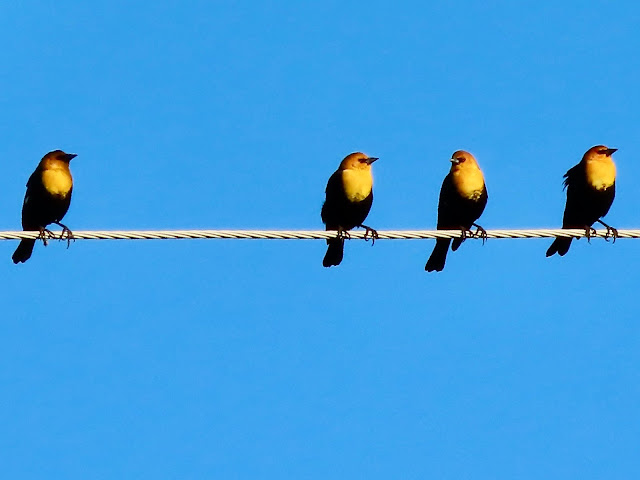Saturday, January 9, 2021
The “Flats” hold a mystique for me that draws me to its 300 square miles of “flat land” that incorporates four cities: Arizona City, Eloy, Red Rock and Picacho. How, then, could two full years have elapsed since my last visit (Glenda’s car) through deep mud on its dirt roads and a bit of rain? Maybe that was it! Plus my choice to bird closer to home since the original “Stay at Home” orders during the original outbreak of Covid 19 in March 2020 (and subsequent worse outbreaks). That lapse of time turned into a strong desire to get back out there. Having nothing to do with my decision was a reported sighting of 75 Crested Caracara two days ago by Doug Jenness!!
With Hinde Silver, an up and coming birder with me (masked and socially distanced as she sat in the back seat), we departed Apache Junction at 7 a.m. and returned at 4 p.m. Our plan was to change out my known access route learned from leaders of group birders gathered from across the Phoenix area. We live in the East Valley, so we have relatively easy access using the “back way” which by-passes I-10 (or uses it for limited miles). What a welcome change! Driving time: 80 minutes.
No mud or rain today - it was all SUN and DUST!
Ah, the fragrance of Red Rock Feed Lot! Birds galore!! Although a Ruddy Ground Dove had been reported there over the past several months, I haven’t the patience to sort through hundreds of MOURNING DOVES to search for it. I’ve seen it several times previously ; I’m no longer a list-dominant birder; I’ll enjoy the obvious species. The following were there in great numbers, plus others in fewer number.
BREWER’S BLACKBIRD - 390; ROCK PIGEON - 150; YELLOW-HEAED BLACKBIRD - 410; EUROPEAN STARLING - 425; and MOURNING DOVE - 906!
Beyond the feedlot, Sasco Road took us to the Santa Cruz River (hence the name of the Flats) that was deeper than I cared to cross--at least 3/4 the way up the tires of other cars crossing it. Parked, we birded outside the car for a while, seeing the only GREAT EGRET of the day plus the first of many raptor's: two COOPER'S and two RED-TAILED HAWK.
Within a five-mile radius of our next birding Hot Spot,
I spotted two of our "target" bird perched in high trees! We exited the car to get closer to the CRESTED CARACARA.
Uncommon (but not rare) in Arizona, the CRESTED CARACARA is widespread in Mexico, Central and South America but spends some wintertime in the border states of Texas and Arizona. Both a hunter and scavenger, it will feed on roadkill but also runs on the ground of agricultural and cattle fields to secure a fresh meal. (Also seen ocassionally in the West Valley Phoenix agricultural fields.)
Other sightings at this location included many GILA WOODPECKER, COMMON RAVEN, a variety of Sparrows (WHITE-CROWNED, VESPER & SAVANNAH) and RED-WINGED BLACKBIRDs.
AMERICAN KESTREL favored this area of developed barn, deserted house with grass yard, pecan tree fields, and old tall trees. Female and then Male AMERICAN KESTREL below:
Continuing to drive to known locations, we saw many RED-TAILED HAWK, including a HARLAN'S subspecies that is very different in appearance.
Also at this location, we spotted a pair of VERMILLION FLYCATCHER but got a photo of only the male, below: Although we drove the distance to the SW side of the Flats to look for large gatherings of CRESTED CARACARA in the Sunland Gin/Pearce area, we saw but one that was flying overhead toward the east. Believe me, we were delighted with the ones we had seen early on as it's rare to catch them perched close enough for relatively good photos.
Why I stopped counting WESTERN MEADOWLARK, I'm not sure; I was driving and keeping the list and I think I just started to make a mental note of "many" that flew up from roadsides into fields as we went past.
At Hot Spot, Evergreen Turf Sod Farm, we saw no Mountain Plover but a number of WESTERN MEADOWLARK and HORNED LARK with a variety of sparrow. KILLDEER and SAY'S PHOEBE enjoyed the brown/green grass, especially where it was getting watered by the sprinkler system.
Photo above by Hinde Silver
RED-TAILED HAWK = 21; COMMON RAVEN = 113 (low count); SAVANNAH SPARROW = 62.
Ten (10) LOGGERHEAD SHRIKE seemed like a good overall number as I've been seeing fewer and fewer of this raptor-behaving bird.
Of all the bird sighted, there are two that always catch me at the emotional level. One was the male NORTHERN HARRIER - known as the Gray Ghost:
from my files* * *
View this checklist online at https://ebird.org/checklist/S78926990
View this checklist online at https://ebird.org/checklist/S78928522
View this checklist online at https://ebird.org/checklist/S78972792
View this checklist online at https://ebird.org/checklist/S78937314
View this checklist online at https://ebird.org/checklist/S78941665
View this checklist online at https://ebird.org/checklist/S78971810
View this checklist online at https://ebird.org/checklist/S78955043


















No comments:
Post a Comment